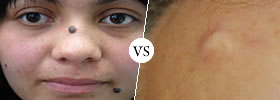Difference between Herpes 1 and Herpes 2
Key Difference: The main difference between Herpes 1 and Herpes 2 is the placement of where on the body the virus is most likely to occur. Herpes 1 is most likely to occur above the belt on the lips and mouth, while herpes 2 will most commonly appear in the genital area.
Herpes is a sexually transmitted disease (STD) that is spread by HSV-1 (Herpes simplex 1) and HSV-2 (Herpes simplex 2) viruses. These are two viruses are from the herpesviridae family and are the most common type of STDs that can infect a person. Both of these infections are extremely contagious and can be spread when an infected person is producing and shedding the virus.

Herpes 1 is most commonly known as oral herpes, though it can also infect the genital area. Herpes 2 is commonly known as genital herpes as it is most commonly found near the genital area. Both the viruses are transmitted by bodily fluids and can cause painful cold sores. The main difference between the two different viruses is the placement of where on the body the virus is most likely to occur. Herpes 1 is most likely to occur above the belt on the lips and mouth, while herpes 2 will most commonly appear in the genital area. Though, herpes 2 can occur near the mouth and herpes 1 can occur near the genital area, it will most likely be a onetime occurrence.
The viruses are transmitted via contact with the infected persons and most commonly via sexual transference. It cannot occur by toilet seats and other external manners. Patients with these diseases must avoid contact with their own lips and be careful while handling their genital areas during an outbreak. Though condoms can help reduce the spreading of this disease, it is only effective if the entire area with the outbreak is covered with the condom. The best way to not spread this disease is to abstain from sex completely until the outbreak has passed.
 An important thing to remember regarding the herpes virus is that once it enters the body, it remains there in the nerve cells, inactive until something triggers it to make it active. There is no cure for the virus, however there are treatments that are available that can help relieve the symptoms during an outbreak. Other medications can also be provided in order to decrease the number of outbreaks a person has. Herpes can also be passed from one person to another even when the blisters or an outbreak is not present. In severe cases the herpes 1 can also spread to the eyes and can cause the person to go blind. It’s always best to get checked in order for herpes.
An important thing to remember regarding the herpes virus is that once it enters the body, it remains there in the nerve cells, inactive until something triggers it to make it active. There is no cure for the virus, however there are treatments that are available that can help relieve the symptoms during an outbreak. Other medications can also be provided in order to decrease the number of outbreaks a person has. Herpes can also be passed from one person to another even when the blisters or an outbreak is not present. In severe cases the herpes 1 can also spread to the eyes and can cause the person to go blind. It’s always best to get checked in order for herpes.
Symptoms of herpes vary depending upon individuals, the severity of the outbreak and on the location. Less severe symptoms include headache, fever, irritability, inflammation of the lymph nodes, and depression. More severe symptoms include sick feeling, nausea, cold sores, and blister-like sores beneath the skin inside the mouth of genital area. The blisters can rupture into wet sores on the skin during healing process. According to medical research, more than 90% of the population is positive for herpes 1 and approximately 16% are positive for herpes 2.
Image Courtesy: webmd.com, cdc.gov









Add new comment